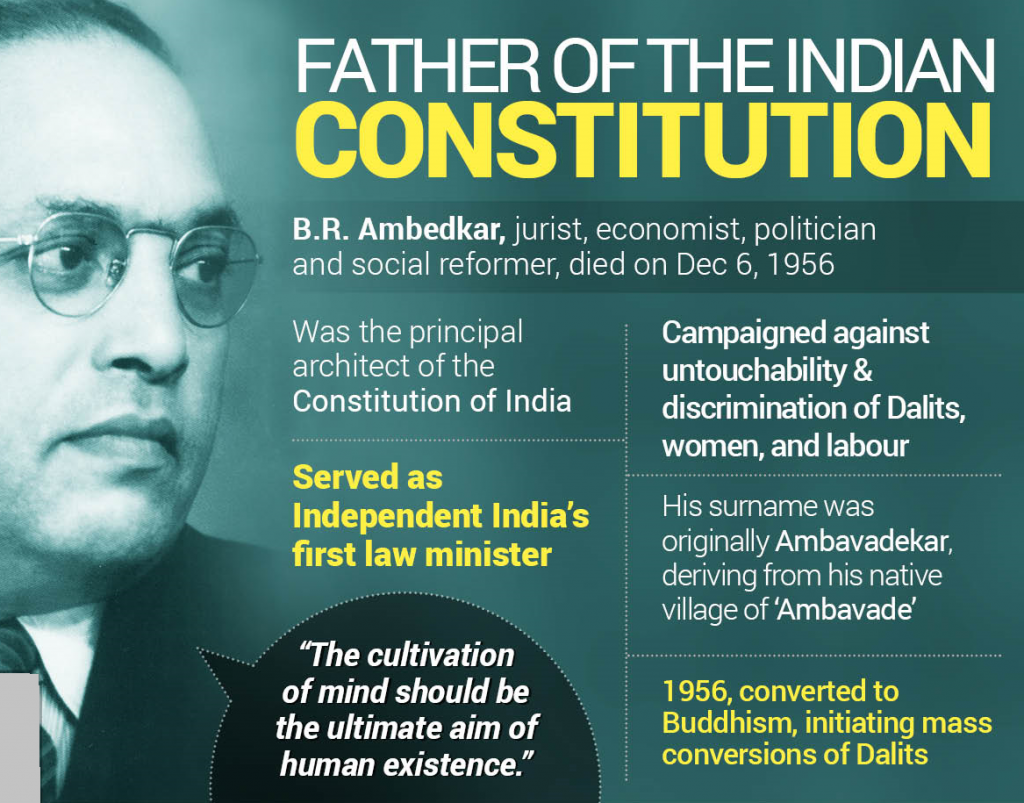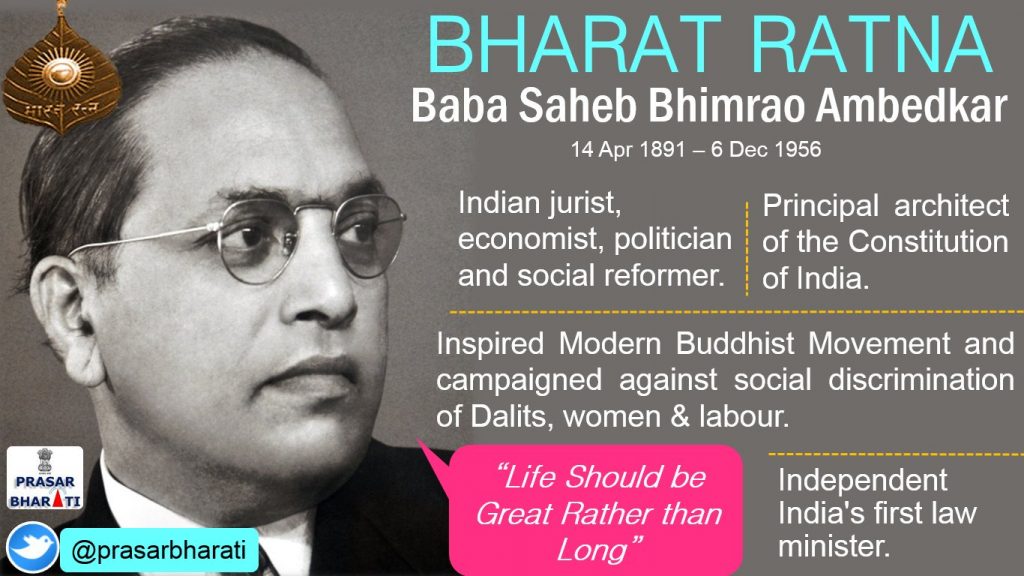Contents
- Dr. Babasaheb Ambedkar Ji
- AYUSH Export Promotion Council
- CPCB
Dr. BABASAHEB AMBEDKAR JI
Focus: GS1; The Freedom Struggle — its various stages and important contributors/contributions from different parts of the country.
Why in News?
PM pays tributes to Dr. Babasaheb Ambedkar on Mahaparinirvan Diwas
About Dr. Babasaheb Ambedkar Ji
- He was born into a caste that was considered untouchable, he faced many injustices and discrimination in society.
- He was born in Mhow in the Central Provinces (modern-day Madhya Pradesh) to a Marathi family with roots in Ambadawe town of Ratnagiri, Maharashtra.
- He Popularly known as Baba Saheb Ji.
- He was the Chairman of the Drafting Committee of the Constituent Assembly and is called the ‘Father of the Indian Constitution’.
- He was a jurist and an economist.

- He was a brilliant student and had doctoral degrees in economics from Columbia University and the London School of Economics.
- The Ambedkar Ji was against the caste-based discriminations in society and advocated the Dalits to organize and demand their rights.
- He promoted the education of Dalits and made representations to the government in various capacities in this regard.

- He was part of the Bombay Presidency Committee that worked with the Simon Commission in 1925.
- He established the Bahishkrit Hitakarini Sabha to promote education and socio-economic improvements among the Dalits.
- He started magazines like Mooknayak, Equality Janta and Bahishkrit Bharat.
- In 1927, he launched active agitation against untouchability.
- He organised and agitated for the right of Dalits to enter temples and to draw water from public water resources.
- He condemned Hindu scriptures that he thought propagated caste discrimination.
- He advocated separate electorates for the ‘Depressed Classes’, the term with which Dalits were called at that time.
- He was in disagreement with Mahatma Gandhi at that time since Gandhi was against any sort of reservation in the electorates.
- When the British government announced the ‘Communal Award’ in 1932, Gandhi went on a fast in Yerwada Jail.
- An agreement was signed between Gandhi and Ambedkar in the jail whereby it was agreed to give reserved seats to the depressed classes within the general electorate, this was called the Poona Pact.
- The Ambedkar Ji founded the Independent Labour Party (later transformed into the Scheduled Castes Federation) in 1936 and contested in 1937 from Bombay to the Central Legislative Assembly.
- He also contested from Bombay (north-central) after independence in the country’s first general elections. but he lost both times.
- He also worked as Minister of Labour in the Viceroy’s Executive Council. After independence, Ambedkar became the first Law Minister in 1947 under the Congress-led government. Later he resigned due to differences with Jawaharlal Nehru on the Hindu Code Bill.
- He was appointed to the Rajya Sabha in 1952 and remained a member till his death.
- He advocated a free economy with a stable Rupee.
- He also mooted birth control for economic development.
- He also emphasized equal rights for women.
- A few months before he died, he converted to Buddhism in a public ceremony in Nagpur and with him lakhs of Dalits converted to Buddhism.
- He authored several books and essays, some of them are as follows;-
- The Annihilation of Caste, Pakistan or the Partition of India,
- The Buddha and his Dhamma,
- The Evolution of Provincial Finance in British India,
- Administration and Finance of the East India Company, etc.
- The Ambedkar Ji considered the Right to Constitutional Remedy as the soul of the constitution.
- The Ambedkar Ji died of ill health in 1956 at Delhi.
- He was cremated according to Buddhist rites in Dadar and a memorial is constructed there, the place is called Chaitya Bhoomi.
- His death anniversary is observed as Mahaparinirvan Din.
- His birth anniversary is celebrated as Ambedkar Jayanti or Bhim Jayanti on 14 April every year.

AYUSH EXPORT PROMOTION COUNCIL
Focus: GS2; Issues relating to development and management of Social Sector/Services relating to Health, Education, Human Resources.
Why in News?
Ministry of Commerce and Industry and Ministry of AYUSH decides to set up an AYUSH Export Promotion Council
About Ayush Export Promotion Council
- The Ministry of Commerce and Industry and the Ministry of AYUSH have decided to work together to set up an Export Promotion Council to boost AYUSH exports.
- It was also decided in the review that the entire AYUSH sector will work together to achieve price and quality competitiveness to boost AYUSH exports.
- The following are the action points that emerged from the meeting:
- The Ministry of AYUSH and Ministry of Commerce and Industry will work together for establishing an AYUSH Export Promotion Council (AEPC).
- The proposed AEPC can be housed at Ministry of AYUSH.
- The Standardization of HS code for AYUSH will be expedited.
- The Ministry of AYUSH will work in collaboration with Bureau of Indian standards to develop international standards for AYUSH products as well as services.
- The Ministry of AYUSH and AYUSH industry will identify best practices/ success stories and promote them amongst the public.
- The AYUSH industry will work on ensuring quality and standards of AYUSH products as well as to become price-competitive.
- The AYUSH will figure in the Brand India activities.
About AYUSH
- The AYUSH is an acronym for Ayurveda, Yoga and Naturopathy, Unani, Siddha and Homeopathy and are the six Indian systems of medicine prevalent and practiced in India and some of the neighboring Asian countries with very few exceptions in some of the developed countries.

- A department called the department of Indian system of medicine was created in March 1995 and renamed to AYUSH in November 2003 with a focus to provide increased attention for the development of these systems.
- This was felt in order to give increased attention to these systems in the presence of a strong counterpart in the form of allopathic system of medicine which lead to an “architectural correction” in the health service envisaged by National Rural Health Mission (NRHM).
- Before the initiation of NRHM most of these systems including workforces, therapeutics and principles were limited to their own field with few exceptions in some states, as health in India is a state issue.
- This took a reverse turn after the initiation of NRHM and the AYUSH systems were brought into the mainstream health care.
- The NRHM came into play in 2005 but implemented at ground level in 2006 and introduced the concept of “mainstreaming of AYUSH and revitalization of local health traditions” to strengthen public health services.
- This concept helped in utilizing the untapped AYUSH workforce, therapeutics and the principles for the management of community health problems at different levels.
- This convergence has been envisaged with the following objectives:-
- Choice of the treatment system to the patients
- Strengthen facility functionally
- Strengthen implementation of national health programs.
- In the mainstreaming of AYUSH and revitalization of local health traditions AYUSH workforce, therapeutics and principles have been implemented in various states at a different level.
VISION and MISSION of the Ministry of AYUSH
- The Vision Ministry of AYUSH has mandate to develop AYUSH systems viz. Ayurveda, Yoga & Naturopathy, Unani, Siddha, Sowa-Rigpa and Homoeopathy.
- The Ministry works with the vision to position AYUSH systems as the preferred systems of living and practice for attaining a healthy India.
- Such a vision has gradually emerged though the thought processes of experts concerned with health care provisioning in the country.
- The Mission The Ministry has identified its Mission in terms of seven broad thematic areas of AYUSH activities.
- The thematic areas are as follows:
(i) Effective Human Resource Development
(ii) Provision of Quality AYUSH Services
(iii) Information, Education and Communication
(iv) Quality Research in AYUSH
(v) Growth of the Medicinal Plants Sector
(vi) Drug Administration
(vii) International Exchange Programme/ Seminars/ Workshops on AYUSH
CENTRAL POLLUTION CONTROL BOARD (CPCB)
Focus: GS3; Conservation, environmental pollution and degradation, environmental impact assessment.
Why in News?
CPCB raises concern on Pollution and Frothing in River Yamuna
About CPCB
- The Central Pollution Control Board (CPCB) of India is an organisation under the Government of India responsible for Air and Water Quality Monitoring Services and any other pollution-related issues.
- The Central Pollution Control Board (CPCB) of India is a statutory organisation under the Ministry of Environment, Forests and Climate Change.
- It Established in 1974 under the Water (Prevention and Control of Pollution) Act and later entrusted with functions and responsibilities under the Air (Prevention and Control of Pollution) Act, 1981.

- Water Pollution
- The Water pollution can be defined as the contamination of water bodies.
- The Water pollution is caused when water bodies such as rivers, lakes, oceans, groundwater, and aquifers get contaminated with industrial and agricultural effluents.
- Air Pollution
- The Air pollution refers to any physical, chemical or biological change in the air.
- It is the contamination of air by harmful gases, dust and smoke which affects plants, animals, and humans drastically.
- It coordinates the activities of the State Pollution Control Boards by providing technical assistance and guidance and also resolves disputes among them.






